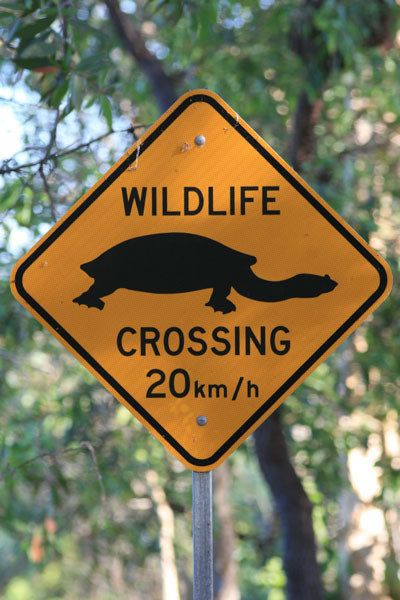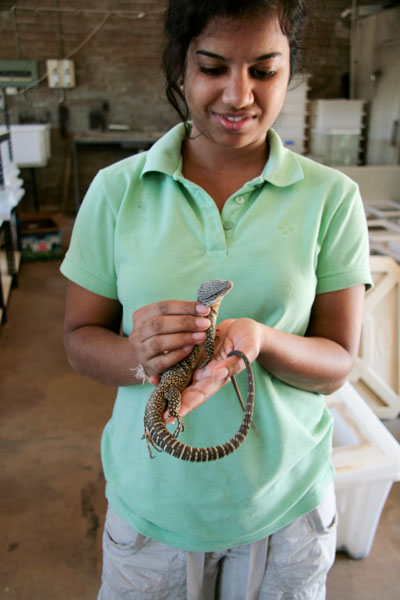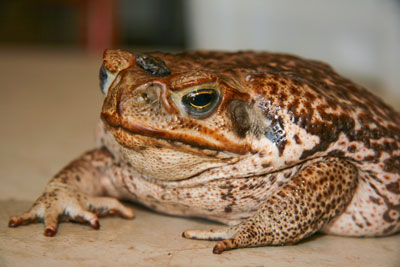Other Australian Scientists Researching Cane Toads
Lots of Australian scientific researchers have worked with cane toads, because they are very common in the suburbs of many coastal cities and towns, are easy to collect and keep, and there aren’t the kind of ethical objections to removing them from the wild, or killing them, as apply to native frogs. Of course, all the same ethical issues apply to humane treatment as would apply to frogs – it’s not fair to blame the toads themselves for their presence in Australia.

Apart from all this “occasional use”, there are a few major Australian
research groups who have contributed to our knowledge of cane toad
biology. The centerpiece of that effort for many years has been James
Cook University (JCU) in Townsville, where Professor Ross Alford has
spear-headed a series of pioneering studies that have set the scene for
our current understanding of toads. Ross has brought lots of others
into the work also, notably Professor Lin Schwarzkopf, also of
JCU. Ross and Lin are major collaborators of Rick and his group, and
co-supervised one of Rick’s former Ph D students, John Llewelyn, who was based at
JCU for his research. That collaboration produced many interesting
results. For example, Ross and Lin radio-tracked toads around
Townsville, and at the Cape York (Queensland) invasion front in the
early 1990’s. Their information on distances moved, activity levels etc
provided a perfect comparison for our own information on the same
topics at the invasion front near Darwin many years later. The changes
were dramatic – the Queensland toads meander about, whereas the Darwin
toads move in almost straight lines, and move much further each day –
and so, are much faster at dispersing into new areas than the Queensland
toads would be.
In Darwin, Professor Keith Christian is working on
quite a few of the local reptiles and amphibians, including cane toads.
Keith has conducted studies on many of these species to see how they
deal with the highly seasonal rainfall (and thus, food supply) in the
“wet-dry” tropics, and has expanded this work to include the cane toads
that have arrived recently. Also at Charles Darwin University, Dr Tony
Griffiths and his collaborators have been documenting the impact of cane
toad invasion on goanna numbers.
Not too far away, Dr Sean Doody and his team have been examining the ecological impact of cane toads on
aquatic predators on the Daly River. Sean worked with Professor Arthur
Georges, the pre-eminent Australian expert on freshwater turtles.
Arthur began studying pignose turtles on the Daly River many years ago,
providing a longterm background understanding of the area’s ecology –
very much like the situation we have at Fogg Dam. That made it much
easier for Sean to document effects of cane toads on freshwater
crocodiles and large varanid lizards (“goannas”) on the Daly. A bit
further upstream, Mike Letnic from Sydney University has also examined
impacts of cane toads on crocodiles, in collaboration with Jonno Webb
and with Rick.
At Fogg Dam itself, Professor Thomas Madsen and Dr Bea Ujvari
(Deakin University) have been marking and radio-tracking goannas,
to understand what happens when toads arrive. Their special interest
in is the genetic factors that allow a few goannas to survive the toad’s
invasion.

Goannas are one of the groups that are most vulnerable to toads. They were studied by Thomas Madsen and Bea Ujvari, as well as by Team Bufo (seen here, Nilu Somaweera at work; photo by Terri Shine)
Another really clever project on toads involves electronic listening posts that scientists from the University of Queensland (Professor Gordon Grigg), University of NSW (Dr Andrew Taylor) and University of Tasmania (Professor Hamish McCallum) set up in advance of the cane toad front. The electronic gadgetry inside the poles “listens” for frog and toad calls, and records where and when the calls are made. The idea was that by measuring calling activity of native frogs, any change in frog numbers due to toad invasion will be obvious.
The main results that are emerging fit well with several other studies
that have been done, including our own (Matt Greenlees estimated frog
numbers before and after the toads arrived at Fogg Dam). Contrary to
lots of people’s expectations, the numbers of frogs didn’t change when
the toads arrived. Basically, what seems to happen is that cane toads
DO compete with frogs to some degree, and DO eat quite a few frogs; and
some frogs DO die when they try to eat baby toads…. But the toads still
don’t reduce frog numbers. Why not? Well, there are two answers.
First, rainfall variation massively affects frog numbers, and local
rainfall patterns probably overwhelm any effect of the toads. Second,
many frog-eating predators die when the toads arrive (after all, cane
toads are basically acting as booby-trapped frogs, from a predator’s
point of view) – and so, survival rates of frogs tend to increase not
decrease when the toads arrive.
At the University of Melbourne, Dr Michael Kearney has been building
mathematical models to help us understand why toads occur where they do –
and how far they might eventually spread. Michael’s models are very
sophisticated, including all kinds of information about the toad’s
temperature relationships and so forth, and are helping us to get a much
better idea about all kinds of issues related to the geographic
distribution of toads.
Dr. Michael Kearney

Many other Australian scientists are studying aspects of cane toads
other than ecology and impact. Professor Rob Capon and Dr Andrew Hayes
(University of Queensland) are looking at cane toad chemicals – poisons,
pheromones and so forth – in collaboration with TEAM BUFO. Professor
Michael Mahony and Dr John Clulow (Newcastle University) have been
exploring the possible use of “sterile males” as a way to control toads.
Their work has been a major influence on Rick’s thinking about how we
might reduce the ecological impact of toads at the invasion front.
Dr. Andrew Hayes
Dr. John Clulow
Professor Peter Koopman and his student John Ambramyan at Queensland
University conducted exciting work on the notion of the
“daughterless gene” - that we could control populations of invasive
animals (like carp, toads etc) by genetically manipulating their
sex-determining systems. The first step is to understand the existing
system (sex chromosomes, etc), and John’s project has done just that.
In Western Australia, Dr Paul Doughty and Professor Dale Roberts are
studying the frog fauna of the Kimberley region, in the hope of working
out exactly what occurs there before the toads arrive and perhaps,
change the system forever. Dr David Pearson, one of the main Team Bufo
collaborators from the Western Australian Department of Environment and
Conservation, is conducting a wide range of studies in advance of the
toad front, again focusing on impacts of toads on the local fauna.
Dr. Paul Doughty
Professor Dale Roberts
Dr. Dave Pearson
At CSIRO in Geelong, Dr Alex Hyatt’s team is working on
alternative virally-based methods of toad control.
At Southern Cross University, Dr Dave Newell has been conducting extensive studies on cane toads at high elevations in the Border Ranges.
Our apologies to any researchers who we have accidentally left out!
Return from Other Australian Researchers
to TEAM BUFO
or to Home Page
